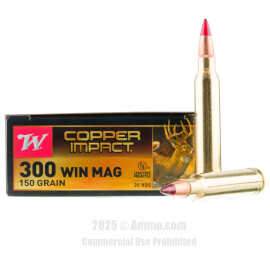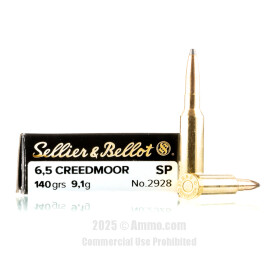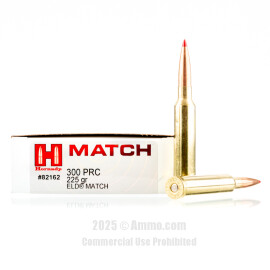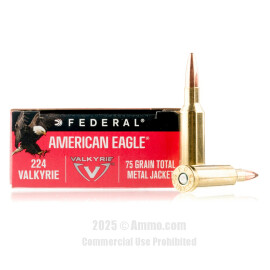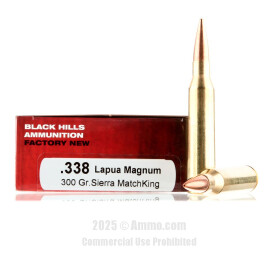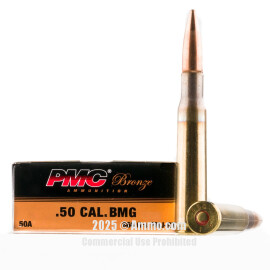Top 10 Best Sniper Rifle Cartridges for When You Need to Make the Shot
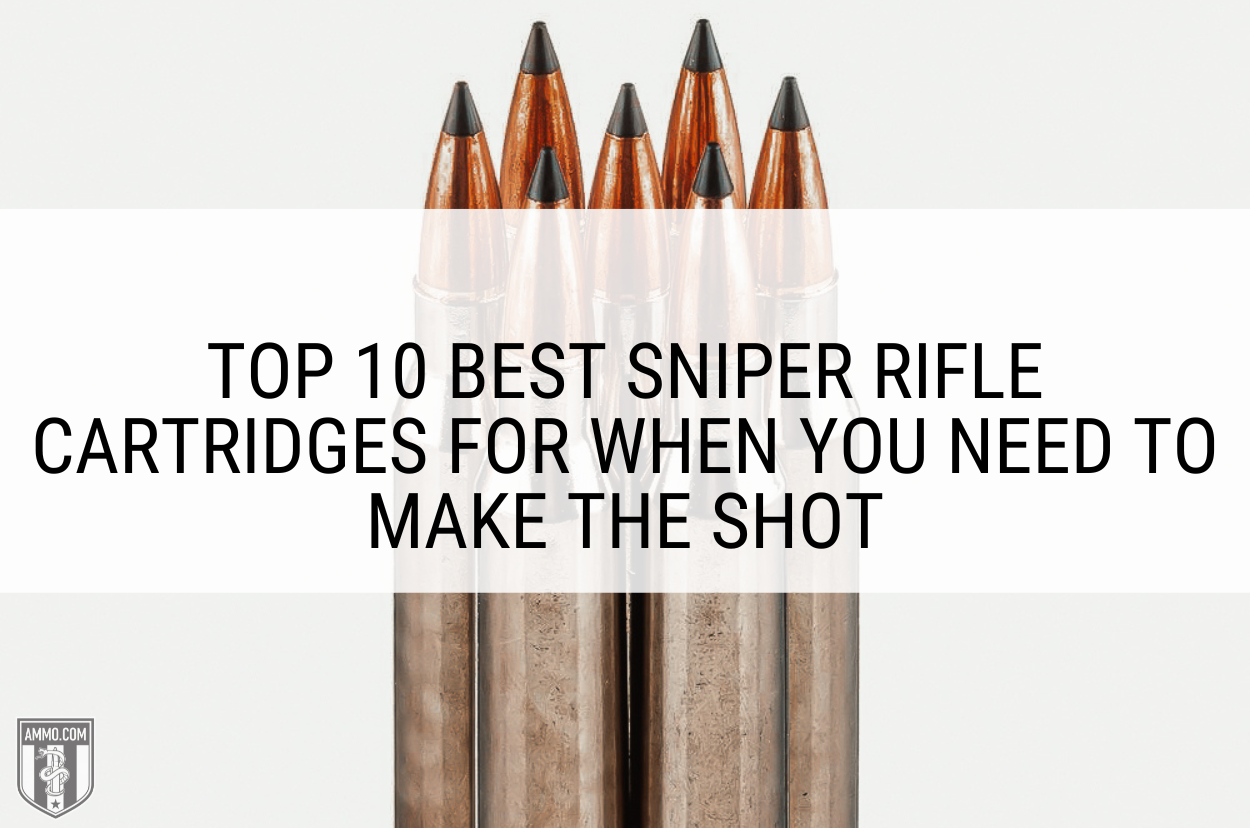
Long-range precision shooting, also known as sniping, is a complex art that requires years of practice, professional instruction, and meticulous attention to detail. While the marksman's shooting ability is crucial to making an accurate shot, picking the right cartridge is just as important.
The right cartridge can help a marksman extend their effective range, enhance accuracy, or deliver the necessary stopping power to take down their target. This article will provide an in-depth overview of the 10 best sniper cartridges available on the market today so you can make the best decision when purchasing your next long-range shooting rifle.
If you simply cannot wait, the best overall sniper rifle cartridge is the 300 Winchester Magnum.
Ranking Procedure
We spent hours researching the top sniper rifle cartridges used for decades by militaries worldwide and the best long-distance cartridges used by skilled civilians for shooting competitions. We’ve fired many of these cartridges, plus spoken with experts to get their take on these rounds.
Top 10 Best Sniper Rifle Cartridges
| 300 Winchester Magnum | Best Overall |
| 6.5 Creedmoor | Best 6.5mm |
| 308 Winchester | Best Inexpensive Mid-Range |
| 300 PRC | Honorable Mention |
| 7.62x54R | Honorable Mention |
| 224 Valkyrie | Best Long-Range .22 Caliber |
| 338 Lapua Magnum | Best for 1,000 Yard Shots |
| 408 CheyTac | Honorable Mention |
| 416 Barrett | Honorable Mention |
| 50 BMG | Best for 2,000 Yard Shots |
.300 Winchester Magnum (300 Win Mag) - Best Overall
The .300 Winchester Magnum, also known as the 300 Win Mag, was released in 1963 by the Winchester Repeating Arms Company initially as a big game hunting cartridge. Although not an immediate commercial success due to staunch competition from the 7mm Remington Magnum, the 300 Win Mag steadily grew in popularity and has become the most popular 30-caliber magnum cartridge on the planet.
Winchester developed the 300 Win Mag using the venerable 375 H&H Magnum as a parent case. Capable of firing bullets between 110 and 220 grains, the 300 Win Mag offers shooters unparalleled levels of versatility when it comes to bullet selection to take on big game from whitetail to moose.
In terms of performance, the 300 Win Mag is widely accepted to have a 1,200-yard effective range on two-legged varmints. However, when using extremely low-drag bullets like the 220 grain Sierra Matchking, military snipers have extended their range out to nearly 1,500 yards.
Offering a nearly 20% increase in muzzle energy over the 30-06 Springfield, the 300 Win Mag can take down any big game animal in North America and all but the largest game animals in Africa.
Although the 300 Win Mag is known for its flat trajectory and amazing terminal ballistics, shooters pay for this performance in terms of recoil. Capable of generating nearly 35 ft-lbs of free recoil or more depending on the load, the 300 Win Mag can be difficult for new or inexperienced shooters to handle.
However, compared to some of the heavy hitters we have on our top ten list (I’m looking at you, 50 BMG!), the 300 Win Mag has relatively mild recoil, especially when tamed with a muzzle brake or suppressor.
Given the popularity of the round, 300 Win Mag ammo is easy to find, and match-grade custom loads are readily available. Furthermore, 300 Win Mag ammo won’t break the bank if you’re looking to buy factory loads while reloading components are readily available.
When you add it all up, it should be no surprise that the 300 Winchester Magnum is our top choice for the best sniper rifle cartridge. It offers precision rifle shooters and military snipers exceptional downrange performance, stopping power, and effective range at a price point that can’t be beaten.
Recommended rounds: Federal 190 grain HPBT (Target Shooting) and Federal 180 grain TSX (Hunting).
6.5 Creedmoor (6.5 CM) - Best 6.5mm
The 6.5 Creedmoor is the cartridge that single-handedly started the 6.5mm cartridge love fest in North America. Introduced in 2007 by Hornady Ammunition, the 6.5 Creedmoor was the product of a gripe session between legendary shooter Dennis DeMille and Dave Emary, the senior ballistician of Hornady at the time.
What they produced was a cartridge that was low recoil, had a flatter trajectory than a 308 Winchester, and was capable of making 1,000-yard shots with relative ease. Extremely tight tolerances in the chamber throat design make the Creedmoor one of the most inherently accurate out of the box rounds available in the market today.
Although the 6.5 Creedmoor began its life as a competitive long-range shooting round, it found itself pushed into service as a hunting cartridge as well. It is extremely effective against whitetail, mule deer, and antelope with impressive terminal ballistics on these medium-sized game animals at longer ranges.
The 6.5 CM can be utilized against elk with proper shot placement and a proper hunting bullet. The Creedmoor’s long, aerodynamic projectiles have incredibly high ballistic coefficients and are typically found inside the 135 to 150 grain weight range.
If you're planning to hunt with the Creedmoor, check out our guide to the best 6.5 Creedmoor hunting ammo to find the top-performing factory loads for the field.
The 6.5 Creedmoor has also received some attention by the U.S. military, as tests of the round by USSOCOM discovered that military snipers doubled their hit percentages at 1,000 yards when switching to the 6.5. Since the 6.5 Creedmoor was designed to fit into a short-action rifle, it is suitable for use in the semi-automatic AR-10 as well as the Springfield M1A and the FN SCAR 20S.
Perhaps the most appealing aspect of the 6.5 CM is its low recoil impulse, making it easier for new or recoil-sensitive shooters to handle. Low recoil also aids in downrange accuracy, as shooters are less likely to develop a recoil-anticipation flinch.
Ammo for the 6.5 Creedmoor is easy to find and inexpensive, as it has quickly become the most popular 6.5mm cartridge in North America. Match-grade ammo is also readily available from multiple manufacturers and virtually every rifle company has multiple precision rifle options available chambered in 6.5 Creedmoor.
Low recoil, inexpensive ammo, and an effective range of 1,000+ yards solidify the 6.5 Creedmoor into our #2 spot for the best sniper rifle cartridge available on the market today.
Recommended rounds: Hornady V-Match 100 grain ELD-VT (Target Shooting) and Winchester Expedition Big Game Long Range 142 grain AccuBond LR (Hunting).
308 Winchester (308 Win, 7.62x51mm NATO) - Best Inexpensive Mid-Range
The development of the 308 Winchester (military designation - 7.62x51mm NATO) began after the Korean War to replace the long-serving 30-06 Springfield round. In 1954, the US Army officially adopted the 7.62x51mm NATO as their new cartridge, and it saw limited service in Vietnam in the M1 combat rifle before being replaced by the 5.56x45mm NATO (223 Rem).
Winchester quickly saw the utility of the 7.62x51mm NATO round on the civilian market and introduced the new rifle cartridge as the 308 Winchester in its short action Model 70 rifle in 1952, two full years before the U.S. Military formally adopted the cartridge.
The 308 Winchester was almost an immediate commercial success for its astounding accuracy, stopping power, and an effective range out to 1,000 yards (with appropriate loadings). Since the 1950s and even up to this day, the 308 Win has been a staple in deer hunting camps and in marksmanship competitions across the globe.
One of the appeals of the 308 Winchester for big game hunting is its versatility in bullet weight, typically ranging between 120 to 180 grains. This allows it to be a great all-around hunting cartridge for whitetail deer all the way up to elk and black bear.
The 308 Win is still in service to this day for use in machine guns as well as for precision work by military snipers. It is the preferred round for the US Marine Corps as well as the Army for their snipers. Law enforcement sharpshooters also utilize the 308 Winchester to great effect as they often do not need the extreme long-range capabilities of heavier rounds.
For newer shooters, the 308 Winchester is relatively easy to handle as it has mild recoil compared to the 300 Win Mag but slightly more than the 6.5 Creedmoor. In terms of ammo availability, 308 Win can be found in all varieties of factory loads. From surplus 7.62 NATO to precision match-grade ammo, the sky is the limit when it comes to the 308!
Although the 308 Winchester might not be as powerful as the 300 Win Mag and has more recoil than the 6.5 Creedmoor, the 308 offers an excellent middle-of-the-road option for precision shooters who are looking for an inexpensive medium-range cartridge.
Recommended rounds: Black Hills Gold 125 grain CX (Target Shooting) and Federal 175 grain Terminal Ascent (Hunting).
300 Precision Rifle Cartridge (300 PRC) - Honorable Mention
The Hornady 300 Precision Rifle Cartridge (PRC) was specifically designed with long-range precision shooting in mind. Hornady developed the cartridge to fire long, aerodynamic, and high BC 30-caliber bullets to be everything long range shooters want but haven’t heard about yet.
The 300 PRC began when the ballisticans at Hornady wanted to bridge the gap between the 300 Winchester Magnum and 338 Lapua Magnum for extreme long-range (ELR) shooters who wanted to air it out past 1,500 yards but not have to endure the shoulder-punishing recoil of the 338.
Other cartridges had attempted this but fell slightly short of the mark, namely the 30 Nosler and 300 Norma Magnum. Barrel life for these cartridges is painfully short, and Hornady wanted to provide shooters with a cartridge that could fire 200+ grain 0.308” diameter bullet while maintaining an acceptable lifespan of the barrel.
Using the 375 Ruger as a parent case, Hornady necked down the cartridge to accept a 30-caliber bullet and set the shoulder angle at 30 degrees, and thus, the 300 PRC was born.
Hornady specifically built the 300 PRC to be a magnum cartridge and did not constrain themselves by using a long action like what happened with the 300 Winchester Magnum. Instead, they build the rifle around the cartridge, and what they got was an extremely accurate long-range cartridge that can easily compete with the 338 Lapua in terms of trajectory.
The 300 PRC embodies everything amazing about the 6.5 Creedmoor and adapts it to 30 caliber. Hornady rolled out their new cartridge at the 2019 SHOT Show and received SAAMI approval in August of 2018.
The initial design for the 300 PRC fires a 212 gr bullet at 2860 fps and 3850 ft-lbs of energy at the muzzle. Hornady also offers factory loads with 220, 225, and 250 grain bullets.
In terms of recoil, the 300 PRC will have around 10% higher recoil than a 300 Win Mag in the same rifle. This isn’t terrible by any stretch, but the 300 PRC does slap a bit harder both downrange and on the shooter’s shoulder.
Ammo availability is a real issue for the 300 PRC, as Hornady is the only manufacturer currently producing factory loads for the cartridge at the time of writing. However, Federal and Berger have plans to introduce their own lines of 300 PRC, which should help shooters acquire brass and match-grade ammo for the cartridge.
Unlike ammo availability, rifles are relatively easy to find chambered in 300 PRC. For out-of-the-box accuracy, you can’t go wrong with a Ruger Precision Rifle, Browning X-Bolt, or Savage 110 Precision for a long-range turnkey setup.
Although ammo might be hard to find for the 300 PRC, the cartridge seems to be on the rise and is an excellent option for shooting a 30-caliber bullet over 1,000 yards.
Recommended rounds: Hornady 225 grain ELD Match (Target Shooting) and Hornady Precision Hunter 212 grain ELD-X (Hunting).
7.62x54R - Honorable Mention
This one might be a bit of a surprise, as Russian ammunition has a bad rap for being inaccurate. However, when properly loaded and paired with an accurized rifle, the 7.62x54R rifle cartridge can be an incredibly accurate round.
The 7.62x54R was initially developed for the bolt-action Mosin Nagant rifle in 1891. However, it is currently in service to Eastern European armies in machine guns like the PKM and the PKP, as well as the PSL and Dragunov sniper rifles.
The 7.62x54R finds itself put into service as a medium to long-range sniper cartridge, as it is slightly more powerful than the 308 Win but less than the 300 Win Mag. This makes for a relatively enjoyable shooting experience that won’t inflict too much punishment on the shooter in terms of recoil.
The main issue when employing a 7.62x54R as a sniper round is finding appropriate long-range ammo. Surplus 7N1 (Russian match-grade ammo) is hard to find these days, which means you’ll need to look to reloading your own rounds if you want to turn your Mosin Nagant or PSL into a precision shooting machine.
However, the long-range effectiveness of the 7.62x54R should not be overlooked, as the round currently holds the #17 spot of the longest-recorded sniper shots in history. Furthermore, the deadliest sniper in recorded history, Simo Häyhä, used a Finnish M28-30 Mosin Nagant and the 7.62x54R to claim the lives of over 500 Russian soldiers during the Winter War of 1939 (using iron sights no less!).
Although it might not be as flashy or advanced as modern cartridges like the 6.5 Creedmoor or 300 PRC, the 7.62x54R is a formidable medium-range sniper cartridge that can be had for a fraction of the cost.
Recommended rounds: Prvi Partizan Match Line 182 grain FMJ-BT (Target Shooting) and Sellier and Bellot 180 grain SP (Hunting).
224 Valkyrie - Best Long-Range .22 Caliber
When you pick up an average, run-of-the-mill AR-15, you often don’t think of it as a rifle that can shoot upwards of 1,000 yards. The 224 Valkyrie was made to change that perception.
At the 2018 SHOT Show, the 224 Valkyrie was released by Federal to provide AR-15 marksmen a soft-shooting semi-automatic cartridge that was capable of matching 6.5 Creedmoor levels of performance.
The 224 Valkyrie was developed around firing 90 grain Sierra MatchKing bullets with a ridiculously high BC of 0.563, putting it on par with the 6.5 Creedmoor and 6.5 Grendel in terms of ballistic performance.
This high BC allows the 224 Valkyrie to shoot upwards of 1,300 yards, affording long-range shooting competitors an incredibly low recoiling, an economic cartridge that can achieve sub-MOA accuracy in a sport often dominated by larger calibers.
Although most sniper rifles are bolt-action, the 224 Valkyrie manages to transform the AR-15 semi-auto rifle into an incredibly versatile long-range tack driver.
Recommended rounds: Hornady 88 grain ELD Match (Target Shooting) and Federal Fusion 90 grain SP (Hunting).
338 Lapua Magnum - Best For 1,000-Yard Shots
Now, we’re entering the world of the extremely long-range (ELR) shooting cartridges that are utilized in sniper rifles.
Development of the 338 Lapua Mag began in 1983 by US-based company, Research Armament Industries (RAI). Their goal was to create a cartridge that bridged the gap between the 300 Win Mag and the 50 BMG.
The design specification required that the cartridge be able to penetrate 5 layers of military-grade body armor at 1000 meters and fire a 0.338” bullet for its ideal sectional density and ballistic coefficient. The targeted muzzle velocity to achieve this requirement was 3,000 fps.
Initial designs for the 338 Lapua Mag utilized the 416 Rigby as a parent case, simply necking it down to accept a 250 grain Hornady A-MAX bullet. Sadly, the 416 Rigby case was not strong enough to withstand the pressures needed to achieve RAI’s ballistic goals.
For reference, the 416 Rigby was designed in 1911 to use cordite as a propellant, not smokeless powder. As such, the Rigby case walls simply could not withstand the savage pressures the new RAI cartridge needed, and the first few batches of the new 338 ammo failed miserably.
At this point, RAI was under pressure from the military to finish their work, and they desperately reached out to the Finnish company, Lapua, in 1984. Straddled with debt, RAI had to drop out of the program and this left the fate of the new cartridge in the hands of the engineers at Lapua.
Never to back down from a challenge, the ballistics team at Lapua joined forces with Sako and Accuracy International to work on redesigning the 416/338 cases into something that could handle close to 60,000 psi of pressure.
At first, the case web and walls were thickened, which helped somewhat. However, the real innovation by Lapua came in the form of hardness distribution (hard to soft) from the cartridge face to the mouth.
The final product was an extremely pressure-resistant case that was able to achieve velocities just short of the initial 3,000 fps goal, but the finalized 338 Lapua Magnum cartridge was submitted and accepted by the CIP (the European version of SAAMI) in 1989 and became a NATO cartridge shortly thereafter.
NATO standard 338 Lapua Mag ammo fires a 250 grain bullet with a muzzle velocity of 3,000 fps and muzzle energy of 4892 ft-lbs.
If you’re familiar with long-range shooting, then you’re likely aware that the 338 Lapua has been responsible for some of the longest confirmed sniper rifle kills in history.
The #4 spot currently belongs to Corporal Craig Harrison of the British Army, firing a 338 Lapua Magnum out of his Accuracy International L115A3. Taking down a Taliban insurgent at 2,707 yards (that’s about 1.5 miles) in 2009, Harrison held the #1 spot for 3 years until he was overtaken by an unnamed Australian sniper who popped another hostile in Afghanistan using a 50 BMG out of a Barrett M82A1.
As for American servicemen who wear the stars and stripes on their shoulders, I would be remiss if I did not mention American sniper legend Chris Kyle, who took down a hostile in the Iraq War at 2,100 yards (1.19 miles) using 338 Lapua Mag. He currently holds the #11 spot on the longest sniper shots in history.
The 338 Lapua Mag can take down every large game animal on the planet, including African elephants, cape buffalo, and rhinoceros, with proper shot placement. It is becoming more popular in civilian long-range shooting competitions since it can remain supersonic past 1,400 yards while maintaining MOA levels of accuracy with proper handloads.
Although the 338 Lap Mag has an amazing trajectory that would make any 6.5 Creedmoor or 300 Win Mag cry, it also has extremely punishing recoil that can be hard to handle without proper training.
Furthermore, 338 Lapua ammo is very expensive when compared to a smaller round like the 308 Win.
The 338 Lapua rifles are also expensive as well, as the action requires reinforcement to handle the pressures generated by the massive round. However, ammo and rifle options are beginning to become more plentiful thanks to high civilian demand for the cartridge for competitive shooting.
If you’re looking to air it out past 1,000 yards, the 338 Lapua is an excellent option that offers incredible terminal ballistics. However, it is an advanced round that requires proper training to truly harness the full potential of and a lot of range time to get accustomed to the recoil. It’s an excellent round that will be utilized by military snipers and civilian marksmen for decades to come!
Recommended rounds: Black Hills Gold 285 grain ELD Match (Target Shooting) and Black Hills Gold 250 grain AccuBond (Hunting).
408 CheyTac - Honorable Mention
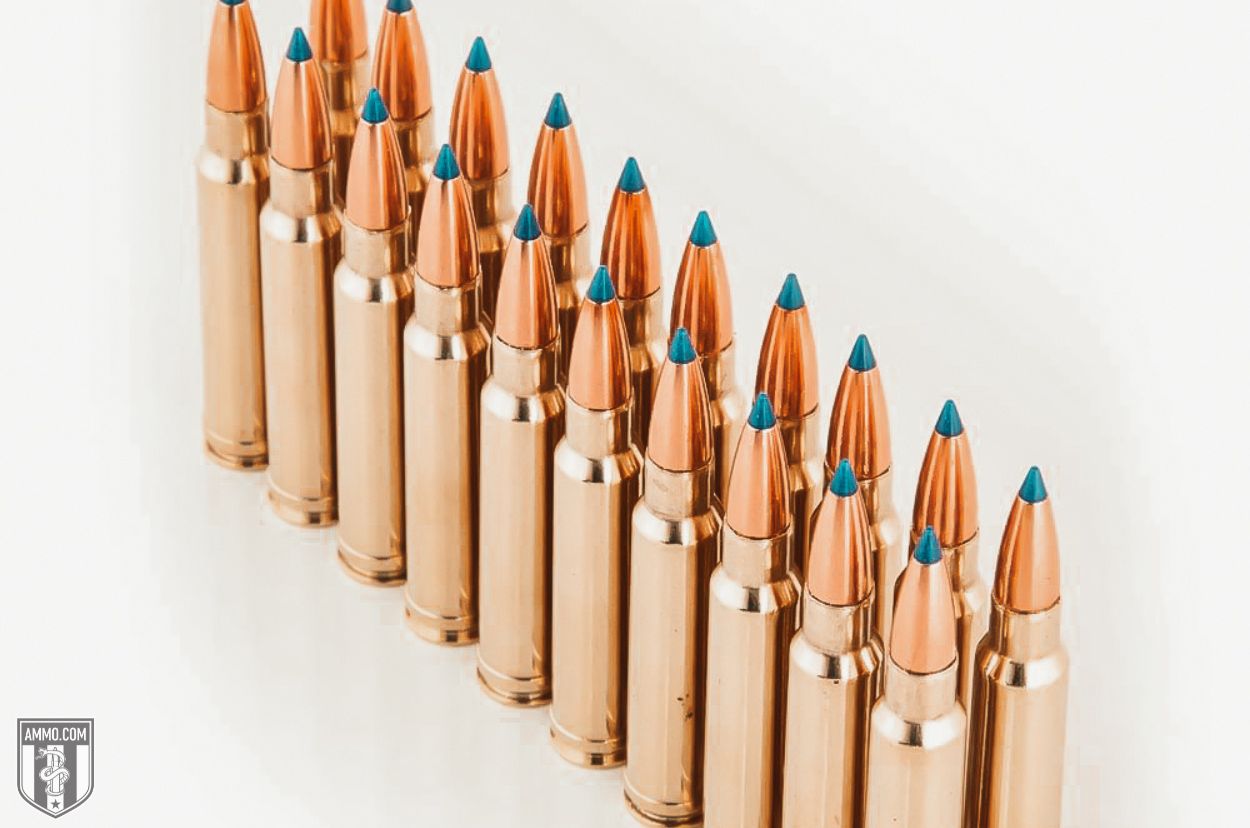
The 408 Cheyenne Tactical (CheyTac) round was developed to directly compete with the 50 BMG and 338 Lapua for military long-range sniper rifles. With an effective range of around 2,200 yards, the 408 CheyTac offers military and civilian shooters incredibly long-range capabilities with equally stout recoil.
Development of the 408 CheyTac began in 2001, although the finalized cartridge was not standardized by the CIP until 2013. Designers John Taylor and William Wordman utilized the 400 Taylor Magnum cartridge as a parent case. This cartridge descended from the 505 Gibbs, which was an old English cordite big game hunting cartridge.
You shouldn’t be surprised if this story sounds somewhat similar to the 338 Lapua Magnum, which began its life from the cordite-fired 416 Rigby case.
Like the 338 Lapua, the older-style cordite cases could not handle the pressures generated by modern smokeless powder. To combat the potential for case-head separation or case rupture (a potentially fatal malfunction), the 408 CheyTac case was hardened in almost the exact same fashion as the 338 Lapua.
The resulting 408 CheyTac cartridge could fire a 305-grain bullet at a muzzle velocity of 3,500 fps and 8,295 ft-lbs of muzzle energy. This offers shooters an incredibly flat shooting rifle that easily surpasses the 338 Lapua in terms of ballistic performance (700 fps and 3,000 ft-lbs more, to be exact!).
Although the 408 CheyTac is a clear upgrade over the 338 Lapua in terms of ballistics, its recoil is considerably heavier and can be hard to control without proper training and range experience. Although it is possible that the 408 CheyTac has been used in specialized military units, it has not been formally adopted by the US military or NATO at the time of writing.
The 408 CheyTac has not seen extensive military adoption outside of specialized units inside the US Special Operations Command (SOCOM), such as Special Forces. However, the CheyTac Intervention sniper weapon system has been featured in multiple video games such as Call of Duty and Battlefield.
If you’re planning on shooting a 408 CheyTac or have need of its long-range capabilities, you’re going to need deep pockets as ammo is extremely expensive. Handloading is virtually a must, as there are only a handful of factory loads available for this incredibly niche round. Bullets for the 408 CheyTac need to be custom ordered, as the cartridge typically fires solid copper projectiles instead of jacketed bullets with a soft lead core.
Rifles are equally difficult to locate and prohibitively expensive for most shooters. Most of the 408 CheyTac rifles on the market will be custom-built bolt-actions that can offer shooters 0.5 MOA accuracy or better. However, whenever the word “custom” is added to a firearm, the price typically goes through the roof.
Unless the 408 CheyTac is picked up as a military round, it is unlikely to see widespread use. However, if you’re looking for a sub-50 caliber sniper cartridge that can reach out past 2,000 yards with relative ease, the 408 CheyTac needs to be on your shortlist.
416 Barrett - Honorable Mention
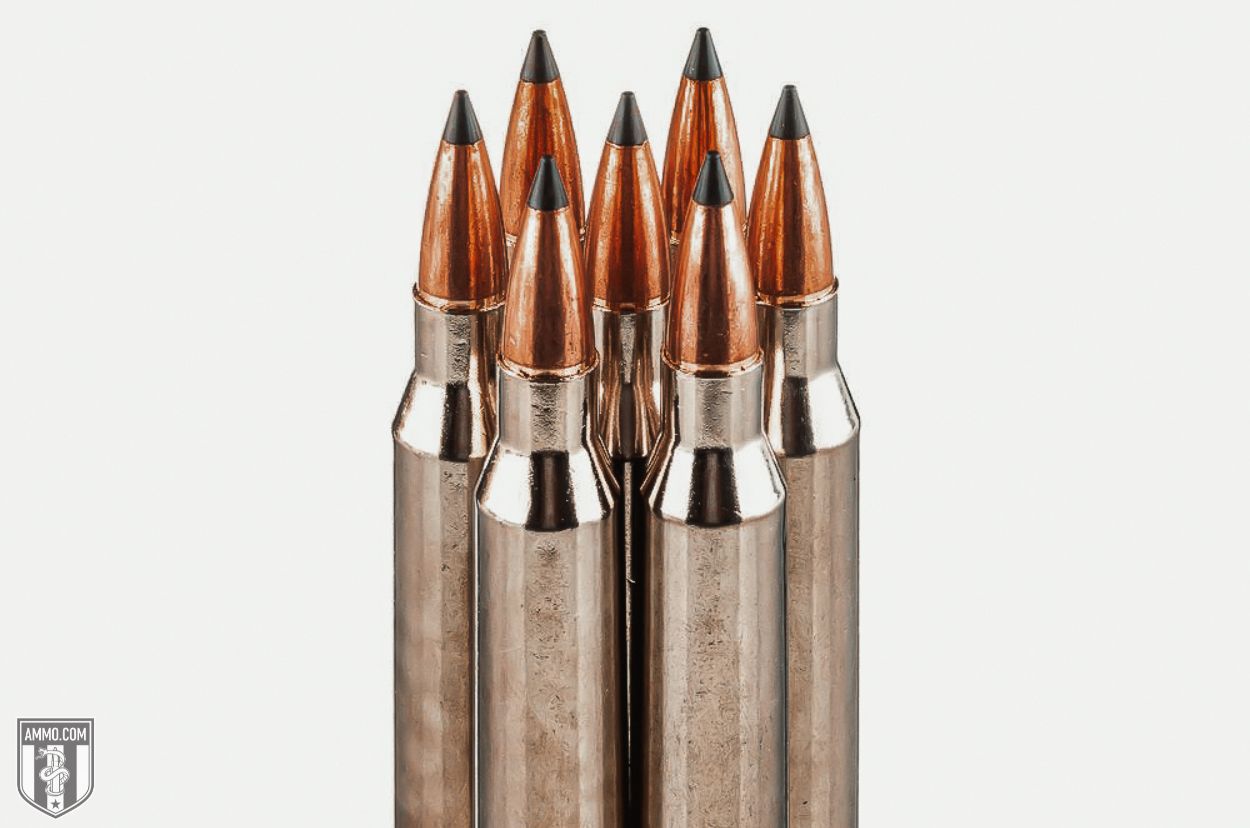
The 416 Barrett is a proprietary cartridge that was developed in 2005 as an intermediate cartridge to bridge the gap between the 338 Lapua and 50 BMG. It was designed specifically for the Naval Surface Warfare Center Crane Division in response to a request for new medium/heavy rifle cartridge.
The designers of the 416 Barrett were Chris Barrett (son of Ronnie Barrett, the founder of Barrett Firearms) and Pete Forras. They developed the cartridge by shortening and necking down a 50 BMG case to accept a 0.416” diameter bullet. This means that the 50 BMG and 416 Barrett have the same base diameter, therefore all that is needed to convert a 50 BMG rifle to 416 Barrett is a barrel change.
Initially, the 416 Barrett was only available in the single-shot bolt action Barrett Model 99. However, since its introduction, Noreen Firearms, as well as Desert Tech also offer precision rifles chambered in 416 Barrett. Furthermore, the semi-automatic Barrett M82A1 is also available in 416 Barrett.
The 416 Barrett offers some shooters 50 BMG ballistics without the issue of actually owning a 50 BMG. Although the 50 BMG is an amazing cartridge, it is illegal in California and several countries like Austria, Belgium, and Argentina, while the 416 Barrett is not.
Developed to fire a 398 gr solid brass bullet, the 416 Barrett can achieve a muzzle velocity of 3,150 fps and a muzzle energy of 8,767 ft-lbs. This ensures the bullet remains supersonic out to 1,900 yards (1.2 miles).
Although the 416 Barrett offers shooters amazing ballistics that rival the 50 BMG, there are a few issues with the round. Those are namely recoil as well as ammo and rifle availability. As mentioned earlier, there are currently only 3 major rifle manufacturers who offer the 416 Barrett chambering. And good luck when it comes to ammo!
The only manufacturer of factory ammo currently is Barrett Firearms themselves. Furthermore, they typically only manufacture small lots of ammo at a time, making it incredibly pricey. This means that if you plan to fire your 416 Barrett on any regular basis, you are required to start reloading your own ammo.
However, if you’re looking for a long-range sniper cartridge that can shoot well over a mile but don’t want to (or can’t) use a 50 BMG, then the 416 Barrett is an excellent option.
50 BMG - Best For 2,000-Yard Shots
And now we’ve come to the granddad of them all, the mighty 50 BMG. The 50 Browning Machine Gun (BMG) is currently the oldest rifle cartridge in service to the US military. It was developed in WWI by John Moses Browning and was accepted in 1921.
Browning designed the 50 BMG at the behest of the Army to provide them with a round that fired heavy projectiles at 2,700 fps. The goal of the round was to penetrate light armored personnel carriers and tanks of the era; however, it was quickly adopted for use in aircraft, for anti-air guns, as well as being mounted on tanks.
Browning produced two firearms for the military that are still in use today almost 100 years later. The M2, also known as the “Ma Deuce,” saw its first action in World War II and has been a staple US military machine gun ever since.
More recently, the 50 BMG has been drafted into long-range sniper rifle service for use as an anti-material cartridge. However, the 50 currently holds the record for the longest sniper rifle kill at 3,871 yards (2.2 miles) by an unnamed Canadian sniper during the Iraqi Civil War in 2017.
The 50 BMG simply dwarfs all the other rounds in our top 10 list. It’s a massive round firing 600+ grain bullets at over 13,000 ft-lbs of muzzle energy. Furthermore, the 50 BMG is one of the few rounds that has a ballistic coefficient over 1.0, meaning it’s incredibly resistant to wind drift, which is needed for extreme long-range shooting.
However, without proper training, the 50 BMG has recoil that most shooters are not prepared to handle. Depending on the rifle weight, some 50 BMG loads can have upwards of 90 ft-lbs of free recoil. Compare that to 20 ft-lbs for the 308 Win, and you can understand why many shooters prefer smaller rounds!
Ammo availability for the 50 BMG is better than some of the other large caliber rounds on our list, as many multiple ammo manufacturers make factory loads for the 50. Furthermore, military surplus 50 ammo is also available at a reasonable price.
For reloading, you’ll need specialized presses and dies, as normal metallic shell reloading presses cannot handle the length of the 50 BMG. The 50 BMG also requires special powders to accommodate for the massive charge and bullet weights it fires.
Rifle availability for the 50 BMG is also considerably higher than for rounds like the 416 Barrett or 408 CheyTac. Multiple rifle makers produce 50 BMG rifles, and most of them come with a muzzle brake and bipod installed at the factory to help mitigate the punishing recoil of the round.
Without question, the 50 BMG is not for beginners and requires a lot of practice to master. Practice can also be an issue, as many ranges forbid the use of the 50 BMG due to the potential for damage to range equipment as well as the comfort of other shooters.
There’s no doubt that the 50 BMG is a potent long-range rifle round that is excellent for shooting at distances well over 1 mile. However, it is very cost-prohibitive for many shooters, and specialized long-distance shooting ranges are required to really train with the round. That being said, if you need to shoot over 2,000 yards and you have the coin to do it, you simply cannot beat a 50!
Recommended rounds: Hornady A-MAX Match (Target Shooting).
Parting Shots – The Best Sniper Calibers
There sure are a lot of different calibers for long-range shooting! And finding the best long-range sniper rifle round for you depends a lot on the terrain you live in and your shooting skill.
For the majority of shooters (and I include myself in this category), the specs of the 308 Winchester or 300 Winchester Magnum are more than enough. These rounds make for excellent long-range target shooting as well as big game hunting, so your hunting rifle can double as a sniper rifle as well.
However, if you have the budget or you simply love shooting bigger calibers, you cannot argue with the power of the 338 Lapua or 50 BMG. Ammo availability is relatively high, and there’s just a mystique about setting up your Barret MRAD bolt-action sniper rifle on the firing line at your local shooting range. Plus, all the looks you’ll get from your fellow shooters are well worth the price once you squeeze the trigger!
No matter which round you choose, make sure to stock up on all your sniper rifle ammo here at Ammo.com, and we’ll see you out on the range!
Cartridge Recommendations
- Best Caliber for Deer Hunting
- Best Big Game Caliber
- The 10 Best Coyote Cartridges
- Best Cartridge for Elk Hunting
- Best Cartridge for Self-Defense
- Best Cartridge for Concealed Carry
- Best Handgun Cartridge
- Best Moose Cartridges
- Best 40 S&W Ammo For Self Defense & Target Practice
- Best 223 Ammo
- Best .44 Magnum Ammo
- Best 270 Ammo for Hunting
- Best 17 HMR Ammo for Varmint Hunting and Plinking
- Best 22 Rimfire Ammo
- 4 Best AK-47 Ammo Picks [7.62x39]
- Best 38 Special Ammo for Self Defense
- Best Handgun Ammo for Self-Defense in Common Calibers
- Best 308 Ammo For Hunting & Target Shooting
- Best 300 Win Mag Ammo
- Best 243 Ammo for Target Shooting
- 10 Best 6.5 mm Cartridges For Long-Range Shooting and Hunting
- Best 45 ACP Hollow Points for Self-Defense
- Best 12 Gauge Ammo for Home Defense
- Best 32 ACP Ammo for Your Pocket Pistol or Backup Gun
- Top 13 Best AR Calibers That Aren’t 5.56 NATO
- Best Ammo for Smith and Wesson M&P 9mm Shield
- Best 7.62x39 Ammo for Self Defense
- Best 20 Gauge Ammo for Home Defense, Whitetail, and Upland Game
- Best Ammo for 1911 45 ACP
- Best 12 Gauge Ammo for Deer Hunting
- Best .40 S&W Ammo for Self Defense
- Best 7.62x39 Hunting Ammo
- Best 5.56 Ammo for Home Defense
- Best 380 Self-Defense Ammo
- Best 45 ACP Ammo for Every Situation
- Best Ammo for Glock 43x
- Top 5 Best 22 WMR Ammo on the Market
- Best Ammo for Glock 19
- Best Sniper Ammo
- Best 38 Special Ammo For Target Practice Precision Shooting
- Top 5 Best 45 ACP Ammo for Target Practice
- Best 6.5 Creedmoor Hunting Ammo
- Top 10 Best Sniper Rifle Cartridges
- Best 6.5 Grendel Ammo
- Best 5.45x39 Ammo for Your Gun
- Best 10mm Ammo for Bear Defense
- Best 350 Legend Ammo
- Top 5 Best 30-06 Ammo for Deer Hunting
- Best 30-06 Ammo for Accuracy
- Best 300 Win Mag Ammo for Deer
- Best M193 Ammo for Stockpiling
- Best 300 Blackout Ammo for a 7.5" Barrel
- Best Shotgun Shells for Target Practice
- Best 45 ACP for Bear Defense
- Best 223 for Deer Hunting
- Best Exotic 9mm Ammo
- Best Duck Hunting Shells
- Best .357 SIG Defensive Ammo
- Best Beretta APX 9mm Ammo
- Best 22 Pistol Ammo
- Best 9mm Ammo
- Best 308 Ammo for Deer Hunting
- Best Ammo for the Taurus GX4
- Best Ammo For Taurus PT111 G2
- Best Shells For Trap Shooting
- Best 38 Special Ammo for Snubbies
- Best 410 Ammo For A Taurus Judge
- Best Ammo for Ruger Security 9
- Best Ammo for Taurus G3c
- Best 7mm Rem Mag Ammo
- Best Lead-Free Hunting Ammunition
- Best 300 Blackout Ammo for Hog Hunting
- Best 9mm Home Defense Ammo
- Best 10mm Ammo for Every Shooting Situation
- Best .22 LR Ammo for Self-Defense
- Best Long-Range Hunting Bullets
- Best 357 Magnum Ammo For Every Shooting Situation
- Best 45 ACP Ammo For Self-Defense
- Best 6.5 Creedmoor Ammo For Accuracy
- Best 45-70 Ammo For Hunting & Target Shooting
- Best Turkey Loads
- Deadliest Shotgun Ammo For Home Defense
- Best 300 Win Mag Ammo For Elk Hunting
- Best 9mm Subsonic Ammo
- Best 7mm PRC Ammo
- Best 300 Blackout Subsonic Ammo
- Best 308 Subsonic Ammo for Hunting
